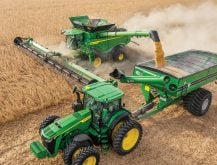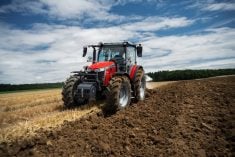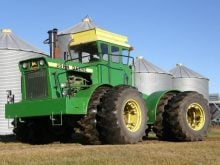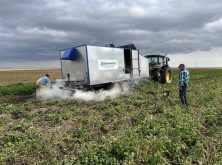In 2021, both John Deere and AGCO announced they were developing selective spraying technologies. Deere introduced its See and Spray Select as an option on model year 2022 400 and 600 series sprayers. That system is capable of identifying weeds in fallow fields and selectively spraying them. It’s what the industry now calls “green-on-brown” technology (which means it can identify green plants in a brown, bare soil environment).
Back in 2015, Germany-based sprayer manufacturer Amazone won a Silver Innovations Award at Agritechnica for its “Intelligent Nozzle” system, which was also a green-on-brown technology. Its sensors could detect the chlorophyll in growing plants and differentiate them from bare ground. In September 2017, the company first showed its UX AmaSpot prototype sprayer, which had that technology built into it, to the farm media at a field day near Bremen, Germany.
Read Also

Claas brings 1000 Series SP forage harvesters to Canada
In mid-August, Claas unveiled its new line of Jaguar forage harvesters at an event in Visalia, California, deep in the heart of that state’s dairy region.
However, AGCO’s system, which is now in field trials, is a “green-on-green” system. That means the sprayer can detect weeds in a green crop and selectively spray them, which is a much more complex task. AGCO’s system was created in partnership with Robert Bosch GmbH and BASF Digital Farming Xarvio Digital Farming Solutions.
In May of 2021, Amazone announced it, too, had teamed up with Germany’s Bosch and the Xarvio agronomic decision-making engine (ADE) from BASF Digital Farming Solutions to build a sprayer with the advanced green-on-green technology incorporated into it.
Bosch’s image recognition system detects any weeds in milliseconds at very early growth stages.
Amazone began its SmartSprayer field trials with the Bosch/Xarvio system in the spring of 2021, incorporating it into a UX 5201 pull-type model equipped with a 36-metre (118-foot) boom.
“The pinpoint application of foliar herbicides will be carried out ‘green in green’ in real time during the day-to-day spraying activities of a large, arable farm,” said the company in a press release. “Full-area application of ground-applied herbicides from an additional tank is also possible on the same pass with a twin line system. Field trials to date show that the use of this technology reduces herbicide use by up to 90 per cent in individual measures, depending on the weed pressure and field conditions. Extensive field trials this year in sugar beet, maize (corn) and rape will further qualify the benefits of this technology.”
The UX 5201 sprayer boom has integrated camera and lighting modules. The brand’s own ContourControl active boom guidance system and SwingStop active vibration damping system help deliver the precision needed for pinpoint selective herbicide applications. The boom uses a combination of individually switched pulse width frequency modulation (PWFM) valves and specially co-ordinated Agrotop Spot Fan nozzles with a 25 centimetre nozzle spacing for enough precision to accommodate working speeds of up to 12 kilometres per hour.
A specially developed LED lighting technology compensates for difficult ambient lighting conditions, such as with shadows and, of course, at night. The company says another advantage of the integrated SmartSprayer solution is its superiority over satellites and drones, as plants are detected in the millimetre range, which makes real-time applications possible.
Various parameters, such as cropping, weed spectrum and weather conditions, are automatically taken from Xarvio Field Manager, processed to create a decision and transferred to the SmartSpraying system. That helps ensure the herbicide application is carried out at the right place, the right time and at the right intensity.
Amazone says there will be a “gradual market introduction of this pioneering SmartSprayer technology … in the coming years.”
When John Deere introduced its See and Spray Select, marketing staff made a point of adding it would soon offer a more advanced version, which likely means it will eventually include green-on-green capability too. With several brands on the verge of delivering that technology, growers will likely see widespread availability of an entirely new way to apply herbicides … in the coming years.
















